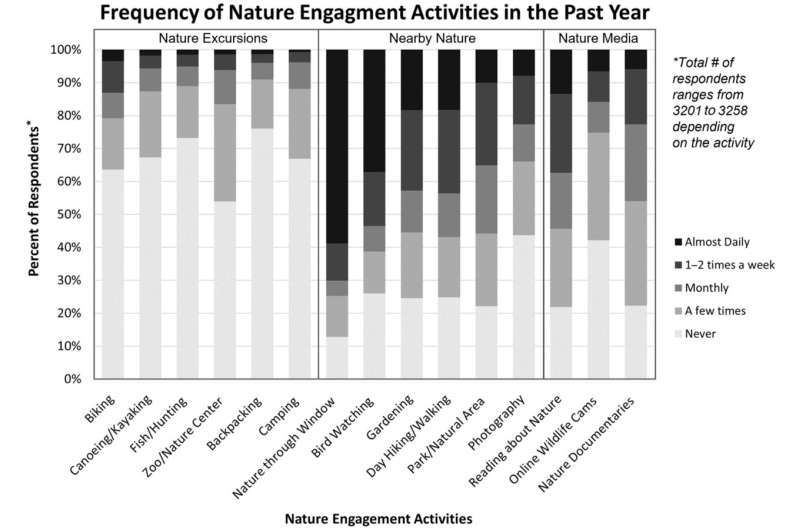This article has been reviewed according to Science X's editorial process and policies. Editors have highlighted the following attributes while ensuring the content's credibility:
fact-checked
trusted source
proofread
Nature close to home associated with well-being during COVID

Again and again, studies have shown that exposure to nature can improve human mental health and well-being. A new study from the Cornell Lab of Ornithology dug a little deeper, looking at what kind of nature experiences were associated with a greater sense of well-being during the COVID pandemic.
Their findings, published in the journal People and Nature, suggest that enjoying nature close to home was associated with the greatest sense of well-being, compared to longer, more intense nature excursions, or nature experienced second-hand through various media.
"I think the thing that really calls to me from this work is the importance of just being able to have a bit of nature that's close by and that you can access even for a short time," said Tina Phillips, lead author and assistant director of the Center for Engagement in Science and Nature at the Cornell Lab.
Though nearby nature engagement came out on top as being associated with a higher overall positive outcome from exposure to nature, there was no correlation with loneliness. Indirect nature experiences through various forms of media had the least beneficial associations. "I think the biggest surprise was that nature excursions were not correlated with better well-being," said Phillips.
"Loneliness was worse for people who did more of those activities, the emotional impact of the pandemic was worse, and reported mental health was worse. The other thing which surprised me was that, across the board, age was the number one predictor of positive well-being outcomes from exposure to nature."
The authors surveyed more than 3,200 U.S. residents in October 2020, 6 months into the pandemic when many lockdowns were still in place. They asked people to rate their levels of loneliness, repetitive negative thoughts, mental well-being, and how emotionally affected they were by the pandemic. The answers given were analyzed along with the frequency with which respondents participated in three types of nature engagement during the pandemic:
- Nearby nature: activities close to home, such as gardening, taking a walk, watching nature through a window, birdwatching;
- Nature media: indirect exposure through reading, nature documentaries, wildlife cameras;
- Nature excursions: more intense experiences requiring planning and travel, such as fishing trips, hunting, backpacking, and kayaking.
Study authors hypothesized that, based on existing literature, any type of nature exposure should be associated with higher levels of reported well-being. Note that this type of research does not establish a cause-and-effect relationship among the study variables, only that both often occur together. It's not necessarily the case that one variable predicts another. Co-author Nancy Wells, a professor in Cornell's College of Human Ecology, says the survey also surfaced ongoing social justice issues around access to nature.
"The pandemic laid bare a host of societal issues and inequities," said Wells. "It is often those with the greatest need who have the least access to nearby nature. Everyone should be able to access the natural environment within a short distance from home. We can make this a reality by protecting natural lands, creating parks, and implementing policies and programs to ensure access for all."
Reaping mental and emotional benefits from nature doesn't have to take a lot of time. "We can't emphasize enough the power of spending even 10 minutes outside," said Phillips. "There's so much evidence that taking the time to be outside in whatever slice of nature is nearby can be so beneficial."
"We hope that we all can carry the lessons from the pandemic–and from this study–into the future," added Wells, "making time in nature a regular part of our routine."
More information: Tina B. Phillips et al, Nature and well‐being: The association of nature engagement and well‐being during the SARS‐CoV‐2 pandemic, People and Nature (2023). DOI: 10.1002/pan3.10433


















